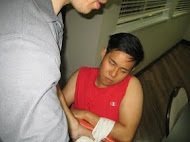Fact Checked
Overview Of A Puncture Wound
- Puncture wounds can be quite deep or superficial. The treatment for a puncture wound depends on how severe the puncture wound is and the extent of the object creating it.
- The main aim is to control bleeding and avoid infections.
Treating A Puncture Wound
- Remain safe. If you are not the casualty, make sure you apply standard safety measures and wear protective clothing if you have access to some.

- For minor puncture wounds that do not need stitches, use antibacterial cream and cover up with bandages.
- Once the bleeding is under control, clean the puncture wound with water and soap. If the bleeding continues again, apply some more bandages and pressure.
- The main purpose is to control the bleeding before doing anything else. Placing force directly on the puncture wound is very effective. To stop the bleeding, the wound should be held above the level of the heart for approximately 15 minutes – this should be sufficient to stop the bleeding. If not, try placing direct force on the pressure points.
- If the puncture wounds are very deep (or if you don’t know how deep the wound is) to the stomach, pelvis, thigh, chest, or if bleeding is continually flowing, phone for an ambulance immediately. Also phone the emergency services for puncture wounds sustained to the neck.
- If the puncture wound is near the chest area, this can result in a collapsed lung. Deep puncture wounds that occur to the chest area should be covered using your hand or a bandage – make sure no air enters the wound. Casualty’s might complain about breathing problems. If the casualty gets worse after covering the puncture in the chest, uncover it.
- Extensive puncture wounds might also require stitches. If the casualty has to have stitches, go to the emergency room.
- Look out for an infection and change the bandages every day. Rinse the puncture wound every time you change the bandages. If the puncture wound starts to swell up or you can see pus – or if redness starts to show – phone a doctor.
- You can use ibuprofen to relieve any pain the casualty might have.
Guidelines
- If the puncture wound is infected, the casualty should phone a doctor for a tetanus injection. Wounds to the feet, those that can’t be cleaned straight away, and wounds created by animals all have a high possibility of infection.
- Puncture wounds that are produced by animal bites might also result in rabies. Always check with your doctor for wounds caused by animal bites.
Related Video On Puncture Wounds
